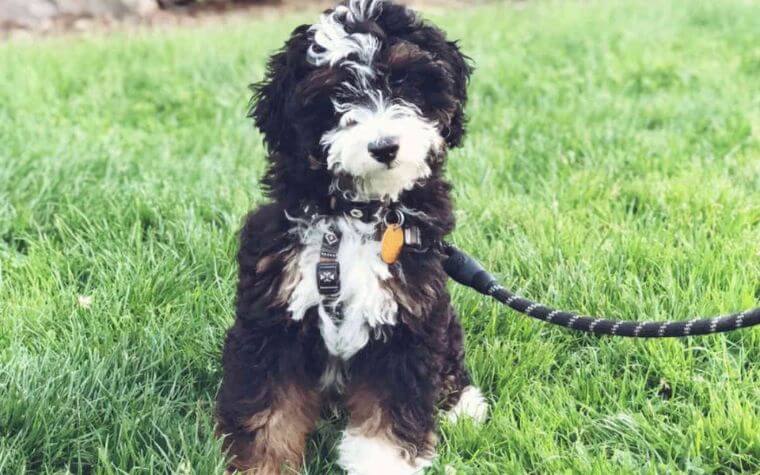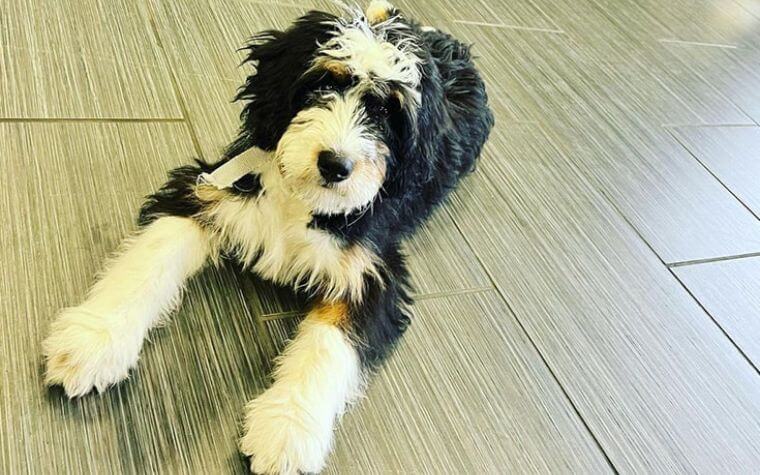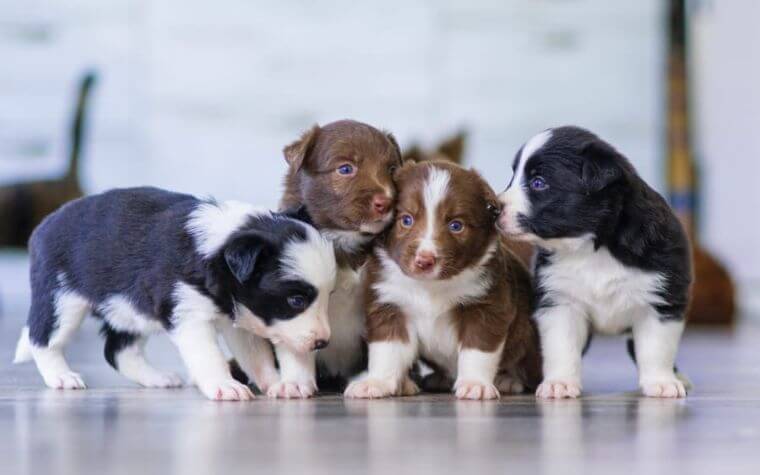Table of Contents
| Breed | Mix Breed |
| LifeSpan | 12-18 years |
| Height | 18-22 inch (mini) 23-30 (standard) |
| Weight | 25-50lbs (mini) 70-90 (standard) |
| Coat | Long and curly |
| Temperament | Playful, Gentle, Kid friendly |
The majority of individuals will tell you that the Small Bernedoodle is a poodle hybrid breed that is a mix of a mini poodle and a Bernese Mountain dog.
Not all Bernadoodles are the result of these two purebreds or variants of their progeny, although this may be true in many instances.
Instead of using purebred poodles, some breeders are starting to employ Australian Labradoodles or other doodle hybrids.
Others will continue to use Bernedoodle while some may modify the name to Australian Bernedoodles. To attain uniform size in the mini Bernedoodle, for example, is one of the justifications offered for this alteration.
Also Read:- Everything to Know About the English Cocker Spaniel
What Is The Price Of A Bernedoodle Puppy? Are They Pricey?

As bernedoodle or mini bernedoodle are a mixed breed of two amazing but expensive breeds, they remain on the pricier side of the market.
Depending upon various factors mentioned below, a puppy for sale can range from 60,000 to 3,00,000 (800$ to 4000$).
The authenticity of the parent breed matters a lot when you buy a hybrid or mixed-breed pup.
What Affects Bernedoodle Prices?

The amount you could have to spend for a Bernedoodle depends on several variables.
Remember that there are other upfront expenses when buying a new dog in addition to the following pricing factors.
- Size and Color
The size and color of the coat can significantly affect the price. The most costly Bernedoodles are often tri-colored Bernedoodles and small Bernedoodles.
- Type of Generation
The generation or genetic make-up of the parents employed in the particular liter might have an impact on the price of the Bernedoodle.
An F2 is a result of when two F1 dogs are crossed. The F1 generation, which is often the most costly, may cost up to $4,000, while an F2 might cost up to $800.
- Coat
A certain coat type may cost extra if the consumer wants it. In general, curly-coated canines will cost more.
Also Read:- Boston Terrier Vs French Bulldog- Who Will Go with Your Personality?
Let’s Learn More About Bernedoodle, Mini Bernedoodle.

The Temperament of a Bernedoodle, Mini Bernedoodle.
If you ask a Bernedoodle owner about their dog’s disposition, you’ll likely hear a range of answers. That’s because each Bernedoodle is unique, just like every person.
They take a lot of their characteristics from their parents’ personalities, upbringing, and training. But when it comes to Bernedoodle, Mini Bernedoodles, there are recurring motifs.
First off, the most frequent criticism of the disposition of Miniature Bernedoodles is that they are obstinate. This is another characteristic shared by Bernese Mountain Dogs.
The tiny Berniedoodle is frequently characterized as having a lot of personalities. They have a reputation for being exceedingly loud and clownish. This vocalization may take the shape of your dog barking, whining, or engaging in vocal conflict with you.
Although most owners note that as pups they are more interested in playing and exploring the world, as they age they become very friendly and devoted to their family, and they adore cuddling time.
They will develop the zoomies, just as other pups. When this happens, they sprint about the home or yard. If you’re not used to it, you could believe your puppy is crazy, but rest assured that it’s just something that happens to puppies.
However, they also know how to relax. In general, Miniature Bernadoodles have more energy than their full-sized counterparts.
Appearance

The soft teddy bears of the dog family are the little Bernedoodles. These sweet tiny dogs seem content and eager for cuddles and affection.
Like any mixed-breed dog, they exhibit a magnificent fusion of characteristics and appearances from the two breeds that make up the Mini Bernedoodle mix.
They have a strong, proportionate frame, and their disposition is cool and joyful. They feature adorable floppy ears, rounder cheeks, and oval-shaped eyes. Their gorgeous tails are long, fluffy, and wag in delight.
Depending on whose generation they belong to, they might come in a variety of sizes because they are a mix of different-sized dogs.
For F1 Mini Bernedoodles, the weight range for Mini Bernedoodles is 30 to 50 pounds. An F1 Mini Bernedoodle may grow to a height of 12 to 22 inches.
An F1b Mini Bernedoodle weighs between 20 to 30 pounds and stands 12 to 20 inches tall on average.
An F2 Mini Bernedoodle will be 12 to 15 inches high and weigh 25 to 35 pounds.
Study the breed generations in more detail.
Petite Mini Bernedoodles and Micro Mini Bernedoodles are Mini Bernedoodles that are under 25 pounds and 12 inches tall.
Their hair sheds very little to none and is partial to completely hypoallergenic. Depending on whether they are more like their Miniature Poodle parent or their Bernese Mountain Dog parent, their coats can be straight, wavy, or curly.
Black, white, and brown hues are also used in conjunction to create little Bernedoodles. Others have stunning, unusual hues on their skin. These include the brown Mini Bernedoodle, blue merle, black, and white Mini Bernedoodle, and merle.
Also Read:- Top 10 Dog Breeds That Are Rare And Unique
Diet

The tiny Bernedoodle requires a healthy diet, much like any other Popular Dog Breed, including kibble, home-cooked meat, or moist texture packets or cans. You must make sure the food you are giving them is simple to digest.
You can offer them some raw food, but avoid giving them undercooked meat. It ought to be at least partially cooked.
It’s a good idea to speak with a veterinarian before changing the dog’s diet or adding any new foods. Feeding veggies like spinach, carrot, asparagus, or pumpkin should only be in moderation.
- Grooming

It’s tough to tell what sort of coat the Bernedoodle will have because they might either inherit the Poodle coat (or any combination of the two!) or a massive thick coat like a Bernese.
As a result, they may not shed or shed very little (as in the case of the Poodle coat), in which case they will need frequent trimming, or they may shed (as in the case of the Bernese coat), in which case they may or may not have an untidy coat that is prone to matting.
With this cross, mats can be an issue, particularly behind the ears, along the side of the neck, on the thighs, stomach, and base of the tail.
Locate a trustworthy local groomer who can either take care of your Bernedoodle’s coat or show you how to do it yourself when their coat grows. Be ready for any because they can range from minimal maintenance to high upkeep.
The maintenance of Poodles’ ears is crucial since they can have issues with too much hair within their ears, which can lead to infections or irritated ears.
Also Read:- Barbado Da Terceira: The Dog Barbie Breed Information
Finding the Best Breeder Isn’t Always Enough; You Also Need to Know How to Deal with Them.

- Check Dog Registrations – Verify with dog registries to see if any Bernedoodles are in there. Registration could be with legal and authentic Canine Partners or with groups like the Designer Breed Registry or the International Designer Canine Registry.
- Request Recommendations — A respectable and high-quality breeder won’t hesitate to provide you with at least two references. Social media can also be helpful in this situation.
- Visit in person instead than speaking on the phone if at all feasible. Request a face-to-face meeting at the location of the puppies.
- Make a list of the questions you want to ask the breeder and don’t be hesitant to ask any of them. Quality breeders will be eager to respond to your inquiries and will even anticipate that you’ll want all the details.
- Request to meet the parents – Consistently request to meet the parents of your puppy. Don’t limit yourself to taking photos. How the parents act has a big impact on how the pups will act as adults.
- Inquire about the dogs’ medical histories. Reputable breeders will make sure their dogs are all in good health and will not be reluctant to share this information with you.
- Build a relationship – Get to know the breeder as well as you can and get to know them well so that you may always feel free to contact them with any questions or concerns you might have, either now or in the future.
